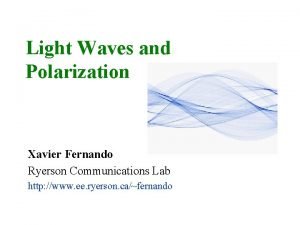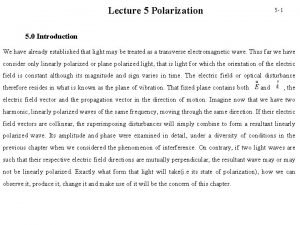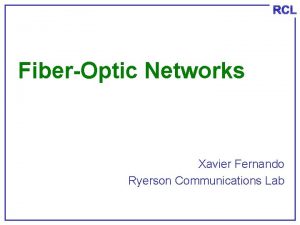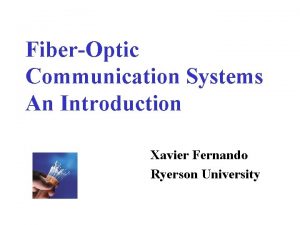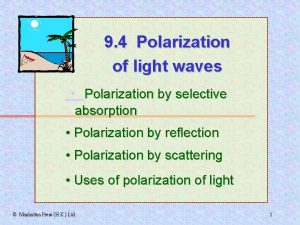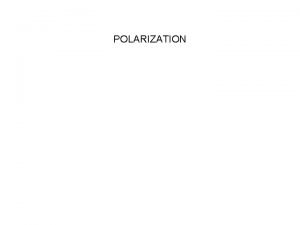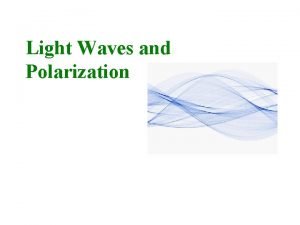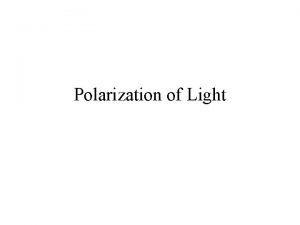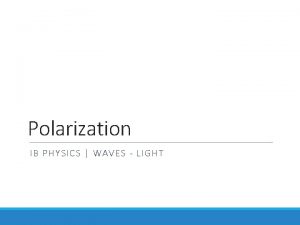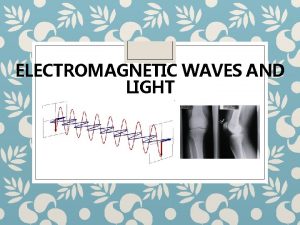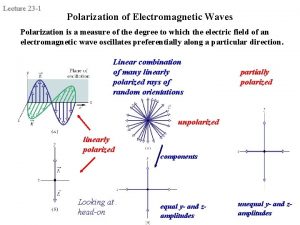Light Waves and Polarization Xavier Fernando Ryerson Communications
























- Slides: 24

Light Waves and Polarization Xavier Fernando Ryerson Communications Lab http: //www. ee. ryerson. ca/~fernando

The Nature of Light • Quantum Theory – Light consists of small particles (photons). This theory better explains light detection and generation processes. • Wave Theory – Light travels as a transverse electromagnetic wave. This theory better explains light propagation. • Ray Theory – Light travels along a straight line and obeys laws of geometrical optics – This theory is useful when the objects are much larger than the wavelength of light (Multi Mode Fiber)

Quantum Theory of Light • Light consists of discrete units called photons. The energy in a photon h= 6. 6256 X 10(-34) J. s is the Planck’s constant and ν is the frequency. • Ex 1: Find the energy of a photon travelling with 200 THz frequency • Ex 2: Show

Wave Theory of Light • Electromagnetic light signal has electric and magnetic fields orthogonal to each other. • The frequency of this EM wave is in the order of THz. Therefore, it is convenient to measure it in terms of wavelength. • where, c - speed of light 3 X 108 m/s in air, - frequency and λ- wavelength • Ex: Find the ν when λ = 1550 nm. • Answer: 193. 5 THz ν

Wavelength Ranges

Plane Waves • Most Light waves are plane waves • A plane wave is a constant-frequency wave whose wave fronts (surfaces of constant phase) are infinite parallel planes. • The electric field vector of a plane wave may be arbitrarily divided into two perpendicular components labeled x and y (with z indicating the direction of travel).

Field distributions in plane E&M waves Electric and magnetic fields are orthogonal to each other and to the direction of propagation Z

Basics about Plane Waves / propagation constant The combined wave s

Phase Velocity vp Phase velocity: co: Speed of light in air n: Refractive index

Phase Velocity • apparent and true depth • Light in fiber core travels slower ‘waveguide dispersion’ Medium Ref. Index Phase Velocity (n) of Light Air 1 3 x 108 m/s Water 4/3 =1. 33 2. 25 x 108 m/s Glass 3/2 = 1. 5 2 x 108 m/s

Changing Refractive Index • The refractive index n is not constant • It is a function of the wavelength of light, n = n(λ). • Therefore, different wavelengths will travel at different velocity in glass fiber • The wavelength dependency of n is given by an empirical formula, the Cauchy or Sellmeier equations

Group of Waves Most practical light sources emit group of waves, not just one 2Δω

Carrier and Envelope vp vg

Group Velocity m/s • Group of waves travel at group velocity, slightly different from phase velocity • The group refractive index ng is a function of n, ω and dn/d ω • If ω proportional to k, then the ng = n and vg = vp. • Usually it is not the case; This results in “Group Velocity Dispersion“. • The GVD is important single mode optical fibers.

Sellmeier Equation • Refractive Index n is a nonlinear function of wavelength • The slope of this graph is related to ng

Polarization • Polarization of a plane wave is the orientation of the oscillations of the E field; perpendicular to the direction of propagation • For a simple harmonic wave, the electric vector in orthogonal directions may have: – Different amplitude – Different phase • The resulting wave is – Linearly, elliptically or circularly polarized

When the orthogonal components have different phase and amplitude, resulting wave is Elliptically Polarized (General Case)

When the orthogonal components have 90 o phase shift and equal amplitude, the resulting wave is Circularly Polarized (Special Case)

When the orthogonal components have zero phase shift, resulting wave is Linearly Polarized • More useful • Emitted by lasers • Polarization control is possible • Horizontal and vertical polarizations

Linear Polarization

Faraday Effect • When a magnetic field is applied to linearly polarized light, the plane of polarization rotates. • The rotation is proportional to the intensity of the applied magnetic field in the direction of the beam of light This effect is used in Optical Isolators

Optical Isolator output polarizer (allows light at 45 o) Faraday rotator Input Polarizer (allows only vertically polarized light) Polarization Controller (creates vertical polarization) • Vertically polarized light enters the isolator. • The Faraday rotator rotates it by 45 o. • Output polarizer passes the light. • Backward traveling (reflected) light starts with 45 o tilt. • It gets horizontal polarization at the rotator and will be extinguished.

Polarization Mode Dispersion (PMD) Each polarization state has a different velocity PMD

Polarization Dependent Modulation
 Xavier fernando ryerson
Xavier fernando ryerson Electromagnetic waves are longitudinal waves true or false
Electromagnetic waves are longitudinal waves true or false Linear polarization
Linear polarization Xavier fernando
Xavier fernando Light polarization equation
Light polarization equation In a curved optical fiber light
In a curved optical fiber light Compare and contrast p waves and s waves using venn diagram
Compare and contrast p waves and s waves using venn diagram Light light light chapter 23
Light light light chapter 23 Into the light chapter 22
Into the light chapter 22 Chapter 22
Chapter 22 Similarities of mechanical waves and electromagnetic waves
Similarities of mechanical waves and electromagnetic waves Mechanical wave and electromagnetic wave
Mechanical wave and electromagnetic wave Difference between mechanical and electromagnetic waves
Difference between mechanical and electromagnetic waves Long waves and short waves
Long waves and short waves Mechanical waves and electromagnetic waves similarities
Mechanical waves and electromagnetic waves similarities Mechanical waves and electromagnetic waves similarities
Mechanical waves and electromagnetic waves similarities Seismic waves
Seismic waves Mechanical waves vs electromagnetic waves venn diagram
Mechanical waves vs electromagnetic waves venn diagram Difference between constructive and destructive waves
Difference between constructive and destructive waves Ryerson library and archives
Ryerson library and archives Characteristics of a longitudinal wave
Characteristics of a longitudinal wave Sound waves longitudinal waves
Sound waves longitudinal waves Examples of mechanical and electromagnetic waves
Examples of mechanical and electromagnetic waves Is a seismic wave mechanical or electromagnetic
Is a seismic wave mechanical or electromagnetic Phcnp
Phcnp


